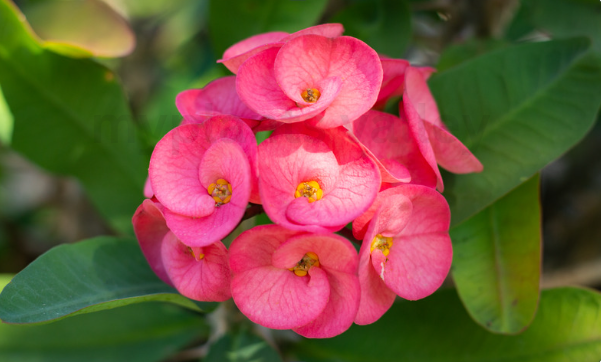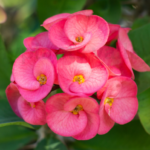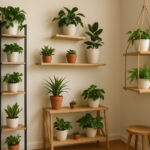Are you considering adding a plant to your indoor space that is both stunning and resilient? The Crown of Thorns (Euphorbia milii) could be the perfect choice. Known for its vibrant flowers and unique thorny stems, this succulent is more than just a decorative plant. But is it really suitable as a houseplant? In this article, we’ll explore its care requirements, benefits, and potential challenges, giving you a clear picture of whether the Crown of Thorns deserves a spot in your home. By the end, you’ll know exactly what it takes to grow this beautiful yet hardy plant indoors.
What is Crown of Thorns?

Crown of Thorns, scientifically known as Euphorbia milii, is a hardy succulent native to Madagascar. It is famous for its striking thorny stems and clusters of small, vibrant flowers that can bloom year-round under the right conditions. The plant typically grows up to 3–4 feet tall indoors and belongs to the Euphorbiaceae family. Its name is derived from the spiny appearance of its stems, reminiscent of the biblical crown of thorns.
This plant is highly adaptable and low-maintenance, making it a popular choice for indoor gardening. It thrives in bright light, well-draining soil, and moderate watering. While it is drought-tolerant and resilient, handling requires care because its sap is mildly toxic and can cause skin irritation. Crown of Thorns is not only admired for its beauty but also valued for its ability to brighten indoor spaces with colorful blooms and unique architectural form.
Origins and Botanical Details
Crown of Thorns is a succulent native to Madagascar, part of the Euphorbiaceae family. Its name comes from the spiky stems resembling the biblical crown worn by Christ, adding a dramatic flair to its appearance. Typically, it grows up to 3–4 feet in height when cared for properly, and its perennial nature ensures longevity with proper indoor maintenance. The plant features small, vivid flowers in shades of red, pink, yellow, and white, which bloom throughout the year if conditions are ideal. Understanding its botanical features helps you provide the care it needs to thrive indoors.
Varieties of Crown of Thorns
There are numerous varieties of Crown of Thorns, each offering unique flower colors and leaf patterns. Popular cultivars include ‘Mini Red,’ ‘Ruby Glow,’ and ‘Orange Queen,’ which vary in size and flower density. Some have striking variegated leaves, while others produce larger, more abundant blooms. Choosing the right variety for your home depends on space, lighting, and the visual effect you want to create. With so many options, it’s easy to find one that suits your interior decor perfectly.
Why Consider Crown of Thorns as a House Plant?
Aesthetic Appeal
One of the most compelling reasons to grow Crown of Thorns indoors is its ornamental value. The thorny stems give it a unique, exotic look, while the bright flowers add a splash of color to any room. Unlike many plants that bloom seasonally, some Crown of Thorns varieties flower year-round under proper care, ensuring your space is always lively and vibrant. Its architectural form works well in both modern and traditional interiors, making it a versatile choice for home decor.
Low Maintenance
If you’re looking for a plant that doesn’t require constant attention, Crown of Thorns is ideal. This succulent is drought-tolerant, needing minimal watering compared to other houseplants. Its hardy nature allows it to withstand occasional neglect, making it perfect for busy individuals or those new to plant care. With the right lighting and occasional feeding, it can thrive for years, rewarding you with colorful blooms and minimal effort.
Ideal Conditions for Growing Crown of Thorns Indoors
Light Requirements
Crown of Thorns thrives in bright, indirect sunlight but can tolerate some direct sun. Place it near a south- or west-facing window for optimal results. Without sufficient light, the plant may become leggy, producing fewer flowers and weaker stems. If natural light is limited, consider using a grow light to supplement its energy needs. Remember, more light usually equals more blooms, so exposure is key.
Temperature Preferences
This plant prefers warm temperatures ranging from 65°F to 85°F (18°C–29°C). It does not tolerate frost, so keeping it away from drafty windows and cold spots is essential. Avoid sudden temperature changes, as this can stress the plant, causing leaves to drop or flowers to fade. Maintaining a stable indoor environment ensures consistent growth and flowering.
Humidity Considerations
Crown of Thorns adapts well to normal household humidity, making it perfect for indoor environments. Unlike tropical plants that require high humidity, it thrives in drier air. However, extremely low humidity may cause the edges of leaves to dry, so occasional misting or keeping it near other plants can help maintain a healthy balance.
Soil and Potting Needs

Best Soil Type
A well-draining succulent or cactus mix works best for Crown of Thorns. This type of soil prevents water from pooling around the roots, which could lead to rot. You can also mix regular potting soil with sand or perlite to improve drainage. Ensuring the right soil is the foundation of a healthy, thriving plant.
Proper Drainage Techniques
Always use a pot with drainage holes. Excess water must be able to escape, preventing root rot. Adding a layer of small pebbles at the bottom can further improve drainage. Remember, waterlogged soil is the most common cause of problems in this otherwise hardy plant.
Watering Crown of Thorns
Frequency and Amount
Watering should be moderate and only when the soil is dry to the touch. During the growing season (spring and summer), water more frequently, but in winter, reduce watering. Overwatering is more dangerous than underwatering, as Crown of Thorns is drought-tolerant and can recover from short dry periods easily.
Signs of Overwatering or Underwatering
Drooping leaves, yellowing, or black spots indicate overwatering. On the other hand, shriveled stems or wilting leaves signal underwatering. Monitoring soil moisture regularly helps maintain the perfect balance and prevents stress to the plant.
Fertilizing Your Crown of Thorns
Recommended Fertilizers
A balanced, water-soluble fertilizer diluted to half strength works best. Fertilizers high in phosphorus encourage flowering, while nitrogen promotes leaf growth. Using the right fertilizer ensures strong stems and vibrant blooms.
Fertilizing Schedule
Feed your plant every 4–6 weeks during the active growing season. Avoid fertilizing in winter when growth slows. Consistent feeding improves flower production and overall plant health.
Pruning and Shaping
When and How to Prune
Pruning helps maintain the plant’s shape and encourages new growth. Trim dead or damaged stems carefully with gloves to avoid thorns and sap, which can be irritating. Regular pruning also helps the plant focus energy on producing flowers instead of excessive foliage.
Encouraging Flowering
Pinching off the tips of young stems stimulates branching and more flowers. Ensure the plant receives adequate light and occasional feeding to maximize blooms. A healthy Crown of Thorns can produce vibrant flowers throughout the year with proper care.
Common Problems and Pests
Aphids, Mealybugs, and Spider Mites
These pests can damage the plant by sucking sap, causing yellowing leaves and stunted growth. Use insecticidal soap or neem oil to treat infestations. Regular inspection helps catch problems early before they spread.
Disease Management
Root rot due to overwatering is the most common disease. Fungal infections can appear as spots on leaves or stems. Avoid excessive moisture and provide proper ventilation to prevent disease. A proactive approach ensures your plant remains healthy and vibrant.
Flowering Patterns and Longevity

Blooming Seasons
Crown of Thorns can bloom year-round in ideal indoor conditions. The flowers are small but numerous, forming clusters that create a striking visual display. Blooming increases with proper light, moderate watering, and occasional feeding.
Lifespan Indoors
With proper care, a Crown of Thorns can live for decades indoors. Its longevity makes it a rewarding plant for long-term enjoyment. Occasional pruning and repotting ensure it continues thriving over the years.
Toxicity and Safety Concerns
For Pets and Children
The sap of Crown of Thorns is toxic if ingested and can irritate skin or eyes. Keep the plant out of reach of pets and children. Using gloves when handling or pruning is highly recommended.
Handling with Care
Be cautious of the thorns, which can puncture skin. Wearing protective gloves and washing hands afterward prevents irritation. Despite these precautions, its beauty and resilience often outweigh the minor handling risks.
Benefits of Keeping Crown of Thorns Indoors
Air Purification
Like many houseplants, Crown of Thorns contributes to better indoor air quality by filtering pollutants and producing oxygen. While not as potent as some tropical plants, it adds a healthy touch to your home environment.
Decorative Benefits
Its colorful flowers and unique form make it a natural centerpiece. Use it in living rooms, kitchens, or even offices to create a striking visual appeal. Its compact size and adaptability make it perfect for indoor decoration.
Caring Tips for Beginners
Mistakes to Avoid
Overwatering, low light, and neglecting pests are common beginner mistakes. Avoid placing the plant in poorly lit areas or using dense, non-draining soil. Learn to read the plant’s cues for water and light needs.
Quick Tips for Thriving Plants
- Provide bright, indirect sunlight
- Use well-draining soil and a pot with drainage
- Water only when dry
- Fertilize during the growing season
- Prune regularly to encourage blooms
Comparing Crown of Thorns to Other Succulents
Advantages
Compared to other succulents, it flowers more frequently and has a unique thorny appearance. Its low maintenance and drought tolerance make it ideal for indoor settings.
Limitations
Its thorns and toxic sap require careful handling. Unlike cacti, it is less frost-hardy, meaning indoor care is essential in colder climates. Knowing its limitations ensures safe and effective care.
Conclusion
Crown of Thorns is undoubtedly a good houseplant for those seeking beauty, resilience, and low-maintenance care. Its vibrant flowers, exotic appearance, and long lifespan make it an attractive choice for indoor spaces. While care requirements are straightforward, precautions around handling its thorns and toxic sap are necessary. With proper light, watering, soil, and occasional feeding, your Crown of Thorns can thrive indoors, providing years of enjoyment and aesthetic appeal. It’s a perfect plant for beginners and experienced plant lovers alike, adding color and character to any home.
FAQs
1. Can Crown of Thorns survive in low light?
It can tolerate moderate light, but flowering will be limited. Bright, indirect light is ideal for blooms.
2. How often should I water my Crown of Thorns?
Water only when the soil is dry. Overwatering can lead to root rot, while underwatering is less harmful.
3. Is Crown of Thorns safe around pets?
No, the sap is toxic if ingested and can cause skin irritation. Keep it out of reach of pets and children.
4. How long does a Crown of Thorns live indoors?
With proper care, it can live for decades, often blooming year-round.
5. Why isn’t my Crown of Thorns flowering?
Insufficient light, overwatering, or lack of nutrients can prevent blooming. Ensure proper care to encourage flowers.







